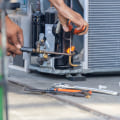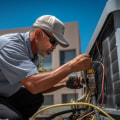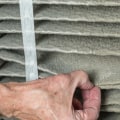The HVAC system is a complex network of components that work together to keep your home comfortable and climate-controlled. The most important parts of the system are the heat exchanger, fan motor, combustion chamber, condenser, evaporator, and thermostat. The thermostat is the brain of the system, allowing you to control when the heating and cooling components are turned on. You may also choose to install multiple thermostats for zoning purposes. The oven and fan motor are two main parts of a home HVAC system.
The oven is usually quite large and requires its own space in the basement, attic or closet. It has a heat exchanger that starts when the thermostat requires heat. If the furnace is powered by gas or oil, the burners perform the heating. If electricity is used as the fuel source, electrical coils heat the air. It's important that the heat exchanger remains sealed, as furnaces that use natural gas or oil fill it with combustion fumes, including toxic carbon monoxide (CO).
Under normal conditions, a vent grille sends these fumes outside where they are harmlessly dispersed in the air. However, if the heat exchanger is broken, these vapors could enter your home and endanger you and your family. That's why preventive maintenance is so important. The condenser is the metal unit located outside the house that expels the heat absorbed from the indoor air to the outside. This prepares the refrigerant for another round through the evaporator coil, where it absorbs more heat and cools the house even more.
Without refrigerant, air conditioning would not be possible. The refrigerant pipes are composed of copper or aluminum and extend between the inner evaporator coil and the outdoor condensing unit. Forced-air heating and cooling rely on ducts to distribute air conditioning throughout the house. It's easier to install ducts during initial construction, although modifications are sometimes possible. If possible, ducts should not go through the attic, garage or mezzanine.
If this is unavoidable, ducts must be sealed and insulated to prevent them from being affected by major temperature differences between these areas and living space. The heat generator is a key component of an HVAC system when it comes to heating. This device generates heat by extracting energy from fuel inside a furnace, also known as a combustion chamber. The hot flue gases will then heat air or another fluid such as water which will then heat the air that enters the conditioned environment. Electrical heat generation could also be used to heat an air conditioner. While there can be a variety of options for heat generators, furnaces are usually most common so it's important to consider their efficiency for resource control and emission of pollutants for environmental reasons related to these components of an HVAC system. Since most heat generators burn fuel as a source of energy, some safety considerations must be taken into account.
This is because combustion systems operate mainly with excess air to reduce combustion temperature and therefore produce lower NOx emissions. Therefore, carbon monoxide would be one of the products of this reaction. A safety problem for heat exchangers is therefore leakage of carbon dioxide into air that passes through flue gas tubes. CO is a colorless odorless gas that can cause headache, dizziness, nausea and even death at high levels. Therefore detectors must also be provided to monitor such leaks. One of the components of an HVAC system called a fan causes air to pass through the heat exchanger into air ducts that would carry warm air to where it's intended.
The fan is driven by an electric motor by a shaft. The airflow can be adjusted by modifying engine speed. Such motors must be of variable speed type. Variable speed motor blowers will gradually achieve higher speeds and therefore reduce amount of noise when less air is required. This gradual increase in speed would also reduce wear and tear of rotating parts as well as energy consumption of unit; therefore operating and maintenance costs would be lower for this type of blowers. One of important components of an HVAC system is compressor or condenser coil which is normally placed outside.
The hot refrigerant gas is brought to compressor to dissipate heat to outside environment and convert it into liquid. This liquid refrigerant is then brought to evaporator coil through copper or aluminum tubes. A fan will increase amount of air that passes through coils and will drive condensation process. The evaporator coil is one of components of an HVAC system located inside and that receives condensed refrigerant liquid from compressor. The liquid refrigerant is atomized by spray nozzles that increase evaporation rate of refrigerant when it comes into contact with warm air in room. There are fans that cause warm air in room to flow through return ducts to evaporator.
Hot air expels heat to atomized refrigerant and cools after which it's redistributed back to rooms through ducts. As air passes over cold evaporator coil its humidity level will decrease due to condensation of humid air in coil. The decrease in humidity makes air feel even colder increasing efficiency of cooling process. Hot gas would be transferred back to condenser coil to repeat cycle. Whether you want to raise or lower temperature thermostat controls when air conditioner turns on.



